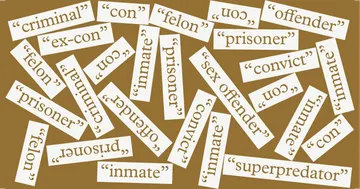Do you have any tips? Feedback? Contact us at bookbans@themarshallproject.org.
The Ohio Department of Rehabilitation and Correction (ODRC) has a host of policies controlling which books people can have in prisons, how they can get them, and what they can do with them.
Incarcerated people in Ohio have been denied access to books like a U.S. Army survival manual, “The Witches’ Bible,” several computer programming guides, prison abolition literature, and a book about imprisoned drug lord El Chapo.
Among the books ultimately allowed through in recent years are “The Art of Seduction,” a compilation of letters to “Penthouse,” “Mein Kampf,” a coloring book featuring designs with profane language, and a different book about El Chapo.
Formerly and currently incarcerated people, authors and nonprofits that send books to prisons say that the ambiguities in the rules and inconsistent enforcement make the system feel capricious. They told us that guidelines about what can get a book banned are vague and overly broad, and prison staff don’t always follow them.
It’s also unclear who is allowed to send books. Officials say there’s no longer an approved vendor list, but documents show prison staff have still rejected books because senders weren’t on the approved list.
In 2019, after ODRC instituted new policies that made it harder for prisoners to receive used books, multiple organizations told media outlets that donating books had gotten harder. In response, the agency carved out an exception for nonprofit organizations that send books to prisons for free.
According to the department’s policy, books being mailed to people inside Ohio prisons are first screened by staff members working in the institution’s mail room. Those employees decide whether to let a book through to the intended recipient, or send it to a managing officer or a staff member designated by the managing officer. That person decides whether to release the book to the recipient, or to send a memo explaining to the recipient why their book is being banned.
Department spokesperson JoEllen Smith said that a book only ends up on the department’s list if the person who was prevented from receiving the book appeals to the Publications Screening Committee. If the recipient didn’t appeal the decision to the committee, the rejected title doesn’t show up on the prison department’s list of banned materials.
Twenty of the 293 banned books don’t cite a specific clause of ODRC’s policy on banned materials. Instead, they are listed as harmful to rehabilitation and prison discipline. That includes 10 books about computers and electronics.
Joshua Bloch, the author of “Effective Java,” a guide to the popular computer programming language, which showed up on the banned list, said he’d never heard of his book being banned in any context until he was asked by The Marshall Project about the state’s ban. Bloch described his book as a style guide for writing good computer code, which could help someone find employment in a high-earning field after their release from prison. He noted it doesn’t delve into topics like hacking or encryption.
The department said in an email that coding books are banned because “the content was found to pose a threat to the rehabilitation of inmates, the security of the institution, and order or discipline of the institution.”
In the January 2019 memo stating the book was rejected from the prison mail room, the prison staff member who initially intercepted “Effective Java” wrote, “Java platform not allowed no receipt or proof for school.”
Smith, the department spokesperson, pointed out that people in prison have access to computers for educational programs and legal research, and that “allowing these types of printed materials presents a substantial risk of misuse” and poses a security threat.
Bloch disagreed. “Could you use [programming skills] for hacking? Well yes, but if you improve your English skills you could use it for social engineering,” he said. “That didn’t seem like a good reason to ban a book.”
“Blood in the Water,” a Pulitzer Prize-winning history of the Attica prison revolt, has been banned from prisons in at least seven states — including New York, where the Attica uprising took place.
The author of the book, historian Heather Ann Thompson won a settlement last year against the New York Department of Corrections and Community Supervision. People in New York prisons, including Attica itself, can now receive a copy of her book after prison staff remove two pages that illustrate the layout of the prison.
Thompson said she generally tries to have copies of her book mailed to people inside prisons who request it. When she discovered that people she’d ordered books for in New York and Illinois hadn’t received them, it gave her grounds for a First Amendment lawsuit as an author whose speech was being restricted.
According to Thompson’s lawsuit against the New York prison system, prison officials blocked her book from reaching people behind bars because it encouraged disobedience toward law enforcement and prison personnel. “At no point is [“Blood in the Water”] a recipe book for what you would do to actually get out of a prison or escape,” she said.
While states like Ohio list criteria about what could get a book banned and the procedures staff must follow to ban a book, Thompson found the standards in many states are vague and applied with little oversight, making prisoners’ ability to read dependent on the whims of prison staff.
“It is utterly at the discretion of corrections officers working in those mailrooms to do what they want,” she said.
In Ohio, if a supervisor blocks a book from reaching someone in prison via mail, the intended recipient is supposed to be notified. The recipient can appeal to the department’s Publication Screening Committee if they disagree with the decision, and the committee will make a formal decision.
Reviewers at both the local and state level seem to take a broad view of what could spark violence.
When someone at Trumbull Correctional Institution tried to obtain a copy of “Buckland’s Complete Book of Witchcraft,” written by one of the founders of the modern Wiccan religion, a prison staff member rejected the book because they said three of the illustrated pages could encourage violence. The diagrams cited are instructions for ritually tying up a consenting participant for a religious initiation ceremony. When the decision was appealed to the Publication Screening Committee, four committee members deferred to the committee member who represented the prison system’s religious services department. That committee member voted to ban the book.
“Black on Black Violence: The Psychodynamics of Black Self-Annihilation in Service of White Domination” was also banned because both a Correctional Reception Center staff member and Publication Screening Committee members said it encouraged violence. But on the page specifically flagged by the prison staff member, the book merely argues that Black on Black violence is a product of white supremacy.
The Ohio prison system’s banned book list also includes books that were screened, but ultimately permitted by the Publication Screening Committee. In some cases, it’s unclear why one book ended up banned, while another was allowed through.
For example, “Hunting El Chapo,” a memoir co-written by Andrew Hogan, a Drug Enforcement Agency officer who helped track the Mexican kingpin, was screened, but ultimately permitted. Meanwhile, “El Chapo: Blood Money,” a short biography of the criminal, was excluded on the grounds that it “facilitates, encourages, incites, promotes, or instructs in, criminal activity.”
Another book that made it through the screening process was an edition of “Mein Kampf,” even though other white supremacist books, like Rise of the Aryans, were banned.
Smith said the key difference is whether the books are illustrated. “DRC only permits a text-only version of Mein Kampf that is devoid of pictures, photographs, drawings, diagrams, etc. of [N]azi symbols,” she wrote in an email. The department’s policy says symbols associated with groups deemed a security threat can be banned, but books can’t be banned for appealing to a specific racial or ethnic group.
It’s also mysterious how some mail rooms decide which suppliers can send books.
For example, Sarah Hainstock, who was in the Ohio Reformatory for Women from 2019 to 2021, said she uses Amazon to send books to friends who are still incarcerated. Some of those materials get through, with varying degrees of difficulty. But in a 2021 lawsuit, the correction department claimed it had a right to reject a white supremacist book because it was shipped from Amazon, which was not an approved vendor.
Redbird, a non-profit organization that donates books to people in Ohio prisons upon request, also has trouble getting books behind bars. Mattie Reitman, a volunteer for the organization, said that most of the time, Redbird doesn’t have any way of knowing if the books it sends reach their intended reader. But the organization has a list of more than half a dozen facilities — including the Allen Oakwood, Belmont, Chillicothe, Lebanon, Madison, and Trumbull correctional institutions, Ohio State Penitentiary, and the North Central and Northeast correctional complexes — where prisoners say Redbird’s books never reached them. On one August 2022 notification Redbird said it received from an incarcerated person, prison staff wrote that the books were rejected because Redbird isn’t approved by ODRC as a vendor.
Smith said that the policy previously only allowed books from approved vendors, but since 2019, the policy requires that the books come directly from a book publisher or distributor. However, the policy doesn’t say who qualifies as a distributor.
After a spate of negative media coverage about donated books being rejected when the rules about vendors changed, department officials promised to create an exception for nonprofit groups. But Smith said that the policy clarification, published in June 2019, only covers materials donated to the prison in general, not to a specific person.
Reitman said getting books to people in Ohio prisons is still a struggle. “I have seen it get worse generally over time, not better,” Reitman said.
CREDITS
Reporting & Writing
Cid Standifer
Visual Design
Elan Kiderman Ullendorff and Bo-Won Keum
Annotated Visuals
Jovelle Tamayo
Style & Standards
Ghazala Irshad
Data processing
Cid Standifer and Andrew Rodriguez Calderón
Development
Ryan Murphy
Audience engagement
Ashley Dye
Story, Data and Visual Editing
David Eads, Raghuram Vadarevu, Marlon A. Walker and Andrew Rodriguez Calderón
Correction: A previous version of this story did not note that Ohio Department of Rehabilitation and Correction's policy includes restrictions on “symbols” and “insignia” associated with groups considered dangerous.

